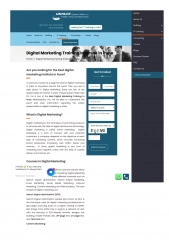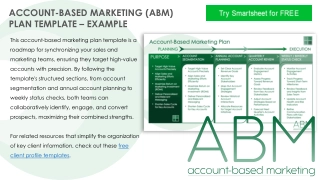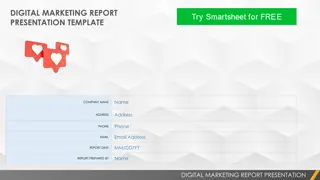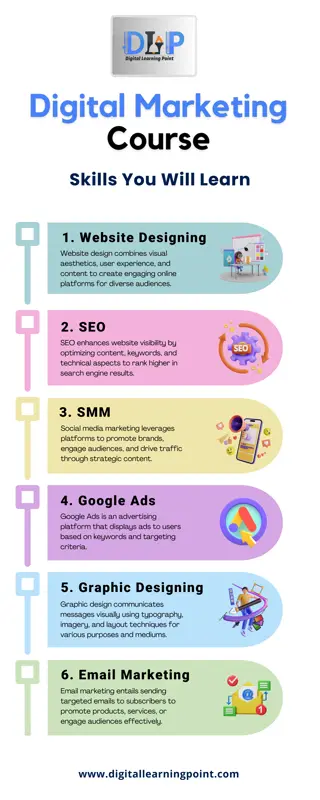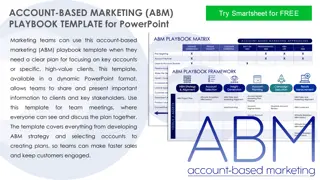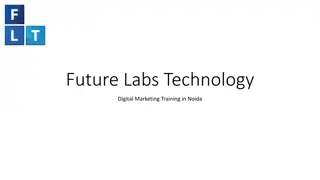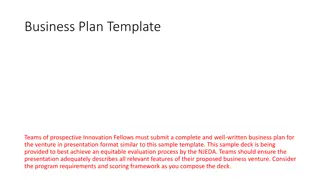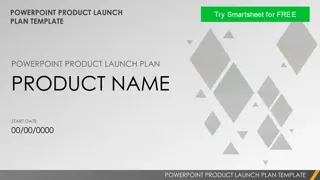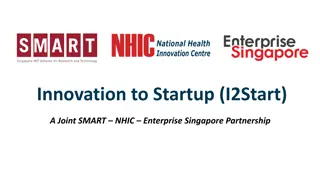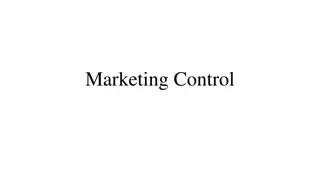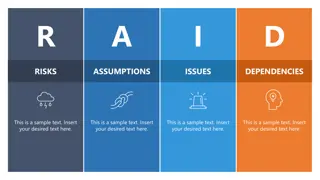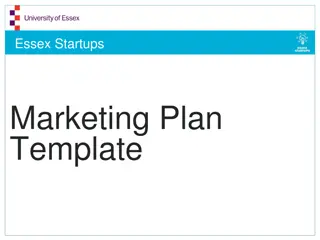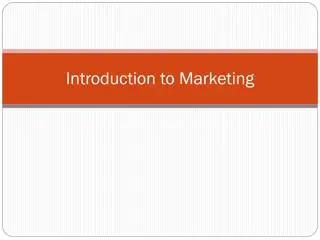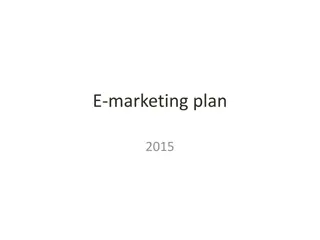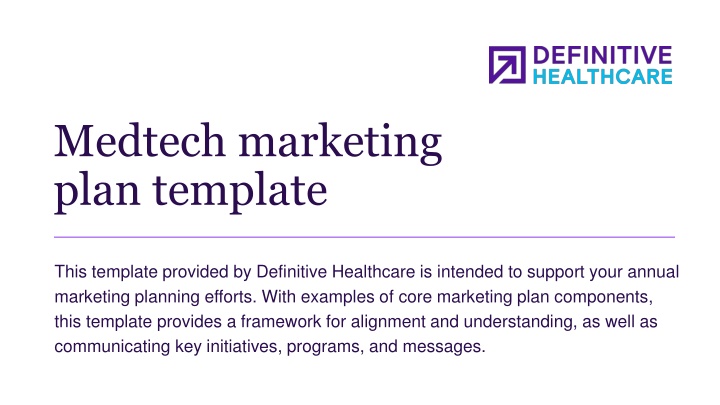
Effective Medtech Marketing Plan for Annual Success
"Explore a comprehensive template for crafting a successful annual marketing plan in the medtech industry. Understand core components, align key initiatives, and utilize color psychology for impactful branding. Gain insights on customer segmentation, pricing strategies, and market understanding to drive your medtech marketing efforts forward."
Download Presentation

Please find below an Image/Link to download the presentation.
The content on the website is provided AS IS for your information and personal use only. It may not be sold, licensed, or shared on other websites without obtaining consent from the author. If you encounter any issues during the download, it is possible that the publisher has removed the file from their server.
You are allowed to download the files provided on this website for personal or commercial use, subject to the condition that they are used lawfully. All files are the property of their respective owners.
The content on the website is provided AS IS for your information and personal use only. It may not be sold, licensed, or shared on other websites without obtaining consent from the author.
E N D
Presentation Transcript
Medtech marketing plan template This template provided by Definitive Healthcare is intended to support your annual marketing planning efforts. With examples of core marketing plan components, this template provides a framework for alignment and understanding, as well as communicating key initiatives, programs, and messages.
Color Psychology create your slideware color scheme Always use an on-brand slide deck issued by your corporate marketing or marketing communications team. If you don t have one, consider color psychology. It s a powerful tool in branding, marketing, and design in general. This chart provides a quick glimpse at the psychology behind 12 of the world s most popular colors. While context and culture matter, research has shown that these are the emotions most often associated with each color. Whichever medium you re working in, this quick reference guide will help you pick the color that best communicates the meaning behind your design. 2 https://www.ignytebrands.com/the-psychology-of-color-in-branding/#3
[Year] [Portfolio name] Marketing plan Your name
Table of contents Business goals and priorities summary: Describe the market Business goals Priority initiatives Customer Understanding: The customer Segmentation and targeting Buying process Understanding personas The competition Identify key competitors Competitor profile The product: Pricing: Product definition Benefits ladder Product / Personas / Messages alignment Competitive performance assessment Market understanding: The market Situational analysis market trends Opportunities and challenges Influencer map Marketing Programs: Marketing budget request summary Marketing programs and high-level execution Guiding principles Current pricing structure Rebate and/or reimbursement structure Goals and recommendations IWIK I wish I knew gap and plan 4
Macro external themes Identify several external and internal concepts to help give purpose to your proposal. Top macro external theme / trend Image or icon placeholder 2nd macro external theme / trend Image or icon placeholder 3rd macro external theme / trend 5
Macro internal themes Identify several external and internal concepts to help give purpose to your proposal. Image or icon placeholder Top macro internal theme / trend Image or icon placeholder 2nd macro internal theme / trend Image or icon placeholder 3rd macro internal theme / trend 6
Business goals and priorities
Total market overview Use this slide to populate relevant details of your total market overview, including your company performance. Overview of what the market encompasses Your market definition Your product types Your ideal patient population Your treatment or diagnosis landscape Competitors and new market entrants Your prior FY results (if available) Actuals (chart) AOP/LRP comparison (chart) Market share by competitor 8
Portfolio overview Insert your own breakdowns of your current portfolio. Which products/ product lines are selling the most versus least? What s impactful for your business, units, dollars? FY [##] Est. Market Size = $XX Product line B $XXM 22% Product line E Product line A [Details as needed] [Details as needed] $XXM 4% [Your portfolio] [Your portfolio] Est. overall MS%: XX% Est. overall MS%: XX% Product line A: 51% Product line B: 22% Product line C: 19% Product line D: 5% Product line E: 4% $XXM 5% Product line D $XXM 51% $XXM 19% Product line C [Details as needed] 9
Market overview Use this slide to highlight additional details breakout of your top selling products within portfolio and more. Product line specific FY results Actuals: Additional details about competitors, new innovations, market size, CAGR projections, national procedure volumes, patient population information, or anything else relevant. (Definitive Healthcare can provide intelligence to help you overview your target market). Insert pie charts, other graphs or data points as relevant. 10
Business goals Region (if applicable) List out your company or portfolio specific objectives and KPIs. OBJECTIVE AND KPIs FINANCIAL Achieve Financial item(s) $XXMM Strategic item 1 STRATEGIC Strategic item 2 Strategic item 3 Market share item(s) (E.g. grow market share by 4% for specific product) MARKET SHARE Brand reputation item(s) BRAND REPUTATION 11
Situational analysis External trends This should be a broadly encompassing, detailed list or high- level analysis of external trends in your market. You should indicate headwinds versus tailwinds, the potential impact, and priority level. HEADWIND/ TAILWIND POTENTIAL IMPACT TO [YOUR COMPANY] FACTOR / TREND DESCRIPTION Tailwind Headwind Headwind 12
Situational analysis Internal trends This should be a broadly encompassing, detailed list or high- level analysis of internal trends in your market. You should indicate headwinds versus tailwinds, the potential impact, and priority level. HEADWIND/ TAILWIND POTENTIAL IMPACT TO [YOUR COMPANY] FACTOR / TREND DESCRIPTION Tailwind Headwind Headwind 13
Business goals Region (if applicable) Place your identified headwinds and tailwinds into the corresponding section of this table for an easy-to-view summary. INTERNAL EXTERNAL HIGHER IMPORTANCE / IMPACT Specific internal tailwind Specific internal headwind Specific external tailwind Specific external headwind LOWER IMPORTANCE / IMPACT Specific external tailwind Specific external headwind Specific external tailwind Specific external headwind 14
Influencer map [Product / Product A] (example) Influencer maps can be messy, so play around with your formatting to find the right layout. This should include all areas of influence that may impact the buying process. Think through specific surgical departments, physician groups, personas, GPOs, KOLs, patient impact, government and regulatory agencies, your organization, and your competitors as the manufacturers. Your connecting lines should tie together each area of influence. In the provided examples, there are reciprocating influence lines because the sample environment is connected and has mutual influences. You ll also notice that entities are presented in different shapes than individual influencers. Examples are included in the following slides.
Influencer map [Product / Product A] (example) Key leverage point Circle size indicates extent of influence on purchasing decisions Manufacturer Government & Regulatory Dashed lines show how the influence is either growing or shrinking in the future FDA 3 1 Dietician Gastroenterology GPOs Academics 2 Director of Pharmacy Key opinion leaders Societies Patient
Influencer map [Product / Product B] (example) Key leverage point Circle size indicates extent of influence on purchasing decisions Manufacturer Government & Regulatory 1 Dashed lines show how the influence is either growing or shrinking in the future Director of Pharmacy FDA Academics CFO 2 Key opinion leaders Materials Management Reference sites Patient / Community Societies 3 Nursing GPOs
Marketing program (template details) The below table displays examples with descriptions of marketing objectives for use in your program table MARKETING OBJECTIVES DESCRIPTION A time-bound, strategic campaign aimed at increasing visibility and awareness of your product, company, or brand Awareness Strategic marketing efforts that aim to attract and capture potential decision-maker, influencer, or user interest in your product, ultimately generating valuable leads Lead generation Content, coaching, training, and technology to help reps improve their skills and sell more efficiently; may include the creation of marketing materials for sales to utilize Sales enablement Customer & market insights Market research programs, voice-of-customer programs, surveys, etc. Portfolio expansion Upstream marketing efforts with the goal of exploring opportunities to expand product portfolio or indication Conferences or summits Industry- or company-focused events for the discussion of timely topics Incentives Product- / product line-specific SPIFF programs, if not budgeted through sales
Marketing program (template details example tactics) Academic journal: A scholarly publication containing articles and whitepapers written by researchers, professors, and other experts; typically peer-reviewed Industry society partnerships: Scientific collaboration with known industry societies intended to reach clinical, medical, or scientific buyers, users, or influencers in support of your organization, device, or product Print publications: Hard copy advertisements, whitepapers, journal articles, and other industry publications anything involving words printed on physical media Social media marketing: Using social media platforms to build a company s brand, increase sales, and drive website traffic; can be utilized organically or through paid promotion ABM: Account-based marketing Programmatic advertising: An automated process of placing ads using data about the users to decide which ads will be most effective Symposiums: Events in which experts in a given field meet, present papers, and discuss issues and trends or make recommendations for a certain course of action Banner ads: Use of a rectangular graphic display that stretches across the top, bottom, or sides of a website or online media property; a paid form of advertising Keyword optimization: The process of researching, analyzing, and selecting the best keywords to target for organic search traffic Public relations (PR): Professional maintenance of a favorable public image via strategic communication by or for an organization or public figure Third-party promotion: Utilizing a third- party organization for brand awareness or content promotion for a fee Direct email: Email campaigns sent directly to a defined list of targets, usually to establish a relationship between the brand and the customer KOL champions: People or organizations with considerable decision-making influence and well-respected reputations within an industry Radio advertising: The promotion of products or services via radio or music streaming services; can include standard AM/FM radio stations as well as digital platforms like Spotify, Pandora, YouTube Music, iHeartRadio, etc. TV/Streaming advertising: The promotion of products or services via commercials on television or video streaming services Event/conference sponsorships: Paying a premium to support the efforts of an industry conference, usually in return for brand mentions, advertisements, or sponsored giveaways that are included in the fee Patient support programs/communities: Programs, communities, or advocacy groups that support patient access to care and assist patients with navigating through the complex healthcare system Webinars: Online informational seminars hosted by organizations and broadcasted to a select group of individuals; also referred to as webcasts, online events, or web seminars Retargeting: A dynamic digital marketing strategy designed to engage potential customers who ve shown interest in your brand but haven t converted Geotargeting: A marketing strategy that targets ads based on physical locations Pay per click: A digital advertising model in which a company places an advertisement on a website and pays a sum of money to the host website when a user clicks on the ad In-facility advertisements: Utilizing printed or digital materials within a physician s office or hospital for educating patients on your treatment; can include brochures, branded educational posters, looped videos on a waiting room monitor, etc. NOTE: Definitive Healthcare provides contact details for email marketing campaigns, as well as provides executive contacts, so you can identify who you want to target across varying tactics. SEO strategy: The process of organizing a website s content by topic and keyword to improve the likelihood of appearing in specific search results
Marketing programs summary Summarize key outcomes you are hoping to achieve as well as your total requested annual budget.
Marketing programs (add more slides as needed) The strategic objective column should align with your corporate leadership's or business unit leader's overarching business goals for the year. Your marketing programs and objectives should align with your corporate goals. STRAT OBJ MKTNG OBJ MARKETING TACTIC MEASURE OF SUCCESS (KPI) EST. COSTS ($) SHORT DESCRIPTION TIMING Demand creation Demand gen campaigns $ Awareness campaign Awareness $ Product collateral $ Add other objectives as you see fit, these are examples as you fill out the program template. Key strategic objective 1 (add more categories as needed) Samples $ Sales enablement Website $ Inservicing materials . $ Conference 1 $ Conferences Conference 2 $ Conference 3 $ Incentives SPIFF $
Segmentation structure example Customize this to your target markets and your segmentation criteria. This is an example segmentation structure for hospitals and IDNs. HOSPITALS / IDNS Definitive Healthcare intelligence can provide the details needed to develop your segmentation structure. Competitive Accounts All Commitment to existing portfolio Tier level Tier level Tier level Tier level Member Regional GPO affiliation Ascension Vizient Premier HPG IDN #5 IDN affiliation IDN #4 IDN #1 IDN #2 IDN #3 Short term acute Hospital type Children s VA Specialty Account size (e.g. census beds) 501 > 101-200 201-300 401 - 500 < 100 CB 301-400
Segmentation structure example Customize this to your target markets and your segmentation criteria. This is an example segmentation structure for physicians. PHYSICIANS Definitive Healthcare intelligence can provide the details needed to develop your segmentation structure. Internal medicine Obstetrics/ Gynecology Family medicine Cardiology Radiology Pulmonology Physician specialty Southern California Permanente Medical Group Mayo Clinic Physicians Northwell Health Physician Partners Ascension Medical Group Affiliation type (e.g. physician groups)* Independent 51 > 11-20 21-30 41 - 50 < 10 31-40 Referral volumes** 50k > Annual procedure/ diagnosis volumes** 1001-20k 20k-30k 40k-50k < 1000 30k-40k *Hospital affiliations might also be important for your device **Determine what volumes are appropriate
Segmentation structure example Customize this to your target markets and your segmentation criteria. This is an example segmentation structure for alternative sites. ALTERNATIVE SITES Definitive Healthcare intelligence can provide the details needed to develop your segmentation structure. ASC Imaging center Outpatient clinic Long-term care Facility Type Network Affiliation None- Ascension Health Baylor Scott & White CHI HCA Independent Procedure volume Less than 250 250-499 500-999 1,000-1,999 2,000 +
[Product Line] buying cycle (Example) ~X Month Cycle 1. 2. 3. 5. 4. Identify / Create problem Establish Consideration set Initial presentation VAT Manufacturer selection Trial / Negotiation Example personas Value Analysis Committee CFO Nursing Purchasing Committee review of cost and clinical offering Director of Pharmacy Director of Pharm PICU/NICU CFO Cardiac surgeons Director Materials / Supply Chain ICU Director of Pharm Personas Director of Materials Management IV teams Director Materials /Supply Chain Patient Safety Director Materials / Supply Chain Patient Safety Head of surgery Head of surgery Other surgeons Key decision factors 1. Specific challenges (Examples: Reduce LOS? Reduce readmission rates? Reduce HAI? Improve clinician safety? Reduce medication errors? Reduce repetitive stress injury? Other metric improvements as applicable. Definitive Healthcare provides intelligence on key metrics that can be used to highlight areas of improvement across target accounts. 1. Patient Safety (Include notes about what is relevant) 2. Clinical Outcomes (Include notes about what is relevant) 3. Supply Reliability (Include notes about what is relevant) 4. Economic Value (Include notes about what is relevant) 5. Offering (Include notes about what is relevant)
Key target persona 1 Add as many persona slides as applicable. JOB ROLE Short description of primary job function COMMON TITLES JOB ROLE Alternative role titles Bulleted list of specific challenges they face (Should be encompassing, not exclusive to challenges your product/product solves for; get to know the persona and all of their challenges) CHALLENGES THEY HAVE Bulleted list of specific initiatives or responsibilities (Should be encompassing; get to know the persona in detail) INITIATIVES THEY UNDERTAKE / RESPONSIBILITIES ROLE IN BUYING PROCESS (Decision maker, user, influencers) How they wish to view content (e.g. digital, hard copy, scholarly articles, reports, white papers, conferences) CONTENT PREFERENCES WHERE DO THEY GO TO SOLICIT INFORMATION? Include industry societies, publications, government/regulatory agencies, non-profit organizations, etc.
Key target persona 2 Add as many persona slides as applicable. JOB ROLE Short description of primary job function COMMON TITLES JOB ROLE Alternative role titles Bulleted list of specific challenges they face (Should be encompassing, not exclusive to challenges your product/product solves for; get to know the persona and all of their challenges) CHALLENGES THEY HAVE Bulleted list of specific initiatives or responsibilities (Should be encompassing; get to know the persona in detail) INITIATIVES THEY UNDERTAKE / RESPONSIBILITIES ROLE IN BUYING PROCESS (Decision maker, user, influencers) How they wish to view content (e.g. digital, hard copy, scholarly articles, reports, white papers, conferences) CONTENT PREFERENCES WHERE DO THEY GO TO SOLICIT INFORMATION? Include industry societies, publications, government/regulatory agencies, non-profit organizations, etc.
Key account targets (Top 10) Add in more columns and datapoints as relevant for capturing key account target details. If you have more key account targets (Top 50, for example), add additional slides. Account name Segmentation Location Rep name Opportunity size
Competitive counter detailing Your company logo Competitor 1 logo Competitor 2 logo Competitor 3 logo Has/ Does not have / claims made / other details as applicable for product Product / Product line specific attribute Product / Product line specific attribute Product / Product line specific attribute Product / Product line specific attribute Product / Product line specific attribute Product / Product line specific attribute
[Competitor] Portfolio offering overview [Your Company] Product(s) Competitor Notes Product / Product Line 1 Competitor 1 Specific details about competitor portfolio offering Competitor 2 Specific details about competitor portfolio offering Product / Product Line 2 Competitor 3 Specific details about competitor portfolio offering Competitor 4 Specific details about competitor portfolio offering
Competitor profile [Competitor name] Add additional slides for additional competitors. [PRODUCT / PRODUCT LINE] STRATEGY STRENGTHS (include capabilities that support their strength) Current strategy Detail what you know about your competitor's current strategy: Portfolio depth and breadth, messaging, positioning, perceptions, partnerships, KOL advocacy, etc. Bulleted list of competitor s core strengths and capabilities Future strategy Detail what you know or anticipate in their future strategy: New launches, market expansion, counter-messaging, etc. Bulleted list of competitor s core strengths and capabilities WEAKNESSES (include specific gaps) HOW DO WE WIN AGAINST THEM Bulleted list of specific weaknesses and/or gaps for this competitor Bulleted list of how your company wins against this competitor Bulleted list of specific weaknesses and/or gaps for this competitor Bulleted list of how your company wins against this competitor
[Your product/company] [Competitor] Add additional slides for additional competitors. BENEFITS LADDER [YOUR COMPANY] [COMPETITOR] Bulleted list of emotional benefits (market perception, clinician perception, patient perception) Bulleted list of competitor emotional benefits (market perception, clinician perception, patient perception) EMOTIONAL BENEFITS Bulleted list of functional benefits of product or product line (can include evidence based clinical outcomes) Bulleted list of functional benefits of product or product line (can include evidence based clinical outcomes) FUNCTIONAL BENEFITS PRODUCT ATTRIBUTES Bulleted lists of product attributes Bulleted lists of product attributes
Competitive performance analysis Customer view Key features Your company Competitor 1 Competitor 2 Competitor 3 Common customer conception (e.g. xyz procedure isn t safe, there are widespread supply chain shortages, etc.) Key features to address customer views Specific claim, feature, messaging, process, etc. for which your company has an advantage Competitor claim, feature, messaging, process, etc. for which your competitor is using to address customer views
Aligning products / Target personas / Key messages [PRODUCT / PRODUCT LINE] DECISION MAKER PERSONA USER PERSONA INFLUENCER PERSONA Customer problem / challenges Outcomes sought Portfolio / product to be positioned Product benefit Claims to prove differentiation Key messages Best way to convey Proposed month to be included in campaign marketing
Key messages and competitive assessment Key message 1 Key message 2 Key message 3 TOP 3 PROACTIVE MESSAGES COMPETITOR PRODUCT MESSAGE [YOUR COMPANY] RESPONSE Bulleted list of competitors key messaging Bulleted list your responses to competitor messaging Product / Product Line A Competitor 1 Bulleted list of competitors key messaging Bulleted list your responses to competitor messaging Product / Product Line B Competitor 2 Bulleted list of competitors key messaging Bulleted list your responses to competitor messaging Product / Product Line C Competitor 3
Pricing Guiding principles Listing or chart highlighting specific guiding principles anything applicable to your guiding principles. Examples/ideas to get you started: 5 Ds: DIAGNOSE, DEFINE, DEVELOP, DESIGN, DEPLOY1 Proposing new price increases to offset margin decreases due to inflation Downstream implications to prior price increases Revaluation of current pricing strategy, discussion points to avoid succumbing to the temptation to use price as a blunt instrument for short-term wins 1 Situational analysis and market trends Opportunities and challenges 1. Trakhtenberg, Ilya, et al. Pricing Best Practices for the Medtech Industry: There s No Time like the Present: L.E.K. Consulting. L.E.K., 22 Nov. 2022, www.lek.com/insights/hea/us/ei/pricing-best-practices-medtech-industry-theres-no-time-present.
Current pricing Approach: Include details about your pricing structure and strategy. STRUCTURE Product / SKU Description Other key attribute Market price (ASP) Landed cost (TP0) Margin Margin %
Current pricing Include details or charts for rebate structures, which can be listed out by GPO, tier, or however your rebate program is structured. [REBATE AND/OUR REIMBURSEMENT STRUCTURE] If applicable, include key details about reimbursement through varying payor types and at varying degrees of complexity. Feel free to include landed or TP0 pricing and margin calculations as well. This can help to identify where you want the most customer acquisition.
Overall pricing goals and recommendations Create a list or chart highlighting specific pricing goals. If proposing price changes / increases, lay out your varying scenarios and consider including the following: Timeframe for implementation Impact on GPO cycles Percentage of customer loss Impact on current agreements (if any) Implications to varying market segments
"I wish I knew" (IWIK) Customize this to what you want to know. This can be external items, internal factors you want to understand more about, and whether a budget request is required to gather information. These should be framed as output statements and act as a catalyst to bring clarity to an issue. There are four components to the IWIK process: ASK, BRAINSTORM, CAPTURE, AND DELIBERATE HOW AM I GOING TO GATHER THE INFORMATION / SOURCES I WISH I KNEW TIMING BUDGET



